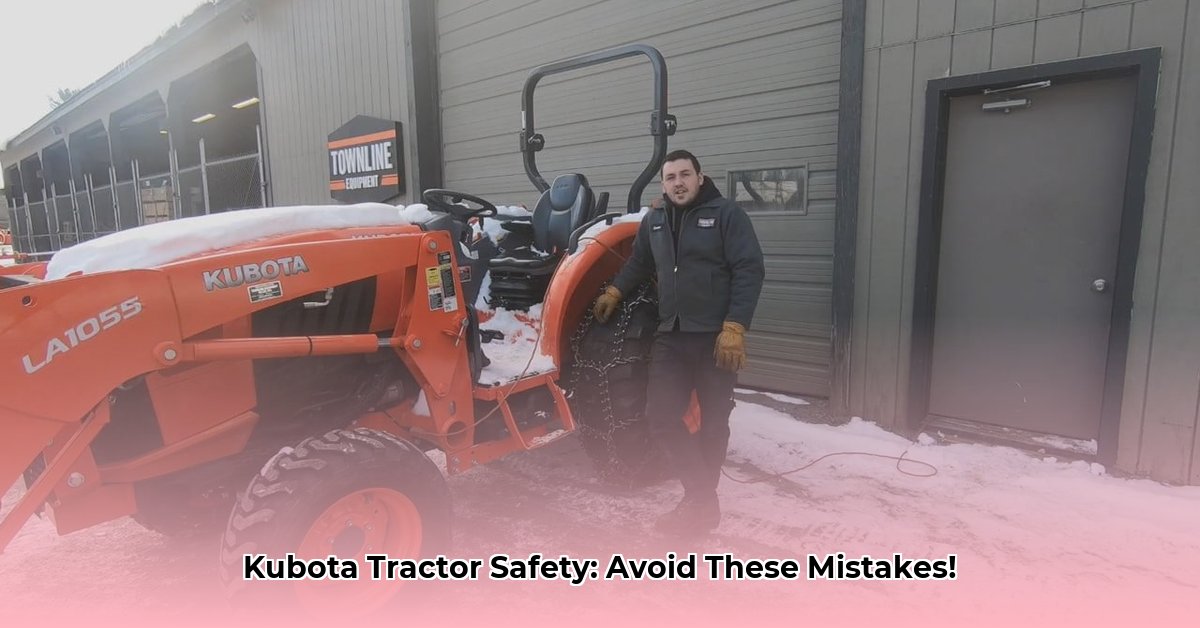
Safety First: Prioritizing Your Well-being
Before even considering starting your Kubota tractor, prioritize safety. This isn't just a suggestion; it's a critical first step. Treat your tractor with the respect it deserves—it's powerful machinery capable of causing serious injury if mishandled. Always wear appropriate personal protective equipment (PPE): sturdy, closed-toe boots (no sandals or flip-flops!), work gloves to protect your hands, and safety glasses to shield your eyes from debris. A helmet can also be a wise precaution, especially for operations involving raised attachments. For more detailed guidance, see this helpful guide on tractor operation.
Before starting the engine, perform a thorough pre-start inspection meticulously. These actions are crucial to minimizing the risk of equipment failure and personal injury. Here’s a pre-flight checklist:
Fuel Level: Ensure your fuel tank is adequately filled. Running out of fuel during operation can lead to costly problems. (Recommended: Never run the tank below ¼ full)
Oil Level: Check the engine oil level using the dipstick. The level should fall between the minimum and maximum markings. Low oil can cause catastrophic engine damage. (Ideal: Keep oil level at midpoint)
Coolant Level: Examine the coolant level in the radiator. It should be within the specified range. Low coolant can lead to engine overheating. (Essential: Use the correct coolant type recommended by Kubota)
Battery Condition: Inspect the battery terminals for corrosion and ensure the connections are clean and tight. A faulty battery prevents your tractor from starting. (Tip: Clean terminals with a wire brush and baking soda paste)
Fluid Leaks: Check for any leaks around the engine, transmission, or hydraulic systems. Even a small leak can be a significant problem later. (Action: Address leaks immediately; consult your owner's manual)
Parking Brake: Firmly engage the parking brake to prevent unintentional movement. Never overlook this critical safety step. (Caution: A disengaged parking brake jeopardizes safety)
Clear the Area: Scan the area surrounding your tractor. Remove any obstacles—rocks, debris, persons, or animals—that might pose a hazard. (Important: Ensuring a safe workspace is paramount)
Pre-Start Procedures: Preparing Your Kubota
With safety checks complete, prepare your Kubota for starting. These steps are universally applicable. However, always consult your owner's manual for model-specific instructions.
Parking Brake Engaged: Verify that the parking brake is firmly engaged. This is a non-negotiable safety measure.
PTO Disengaged: Ensure the power take-off (PTO) is disengaged. This prevents unexpected movement of any attached implements.
Gear Selector in Neutral: Confirm that the gear selector is in neutral. Starting in gear can result in a sudden, uncontrolled lurch forward or backward (Safety Critical: Always check gear selection before starting)
Attachments Secure: Double-check that all attached implements are correctly and securely connected. Loose attachments can be extremely dangerous.
Starting the Engine: Diesel vs. Gasoline
Starting procedures vary slightly between diesel and gasoline engines.
Diesel Engines:
- Turn the ignition key to the "ON" position.
- Wait for the glow plug indicator light to go off (if equipped). This preheats the engine.
- Slowly depress the clutch pedal (if fitted) and press the starter button.
Gasoline Engines:
- Turn the ignition key to the "ON" position.
- Slowly depress the clutch pedal (if fitted) and turn the key to the "START" position.
Troubleshooting Starting Issues: If your Kubota fails to start, check the battery charge, fuel level, fuel filter, and starter motor. Consult your owner's manual for model-specific troubleshooting information.
Understanding the Controls: Mastering Your Kubota
Once the engine is running, familiarize yourself with the controls. Your specific model may differ slightly, so your owner's manual is crucial.
- Steering Wheel/Levers: Controls the direction of the tractor.
- Throttle: Regulates the engine speed.
- Brakes: Used to slow down or stop.
- PTO (Power Take-Off): Engages and disengages power to implements.
- Three-Point Hitch: Raises and lowers rear-mounted implements.
- Differential Lock: Improves traction in slippery conditions.
Basic Operation: Gaining Confidence
Practice basic maneuvers in a safe, open area free of obstacles. Begin slowly, gradually increasing speed as you develop proficiency. Smooth, controlled movements are key to safe operation. Remember:
- Moving Forward: Gently accelerate and steer smoothly.
- Reversing: Proceed very slowly while maintaining alertness to your surroundings.
- Turning: Steer with care, using brakes to control speed and adjust turns as necessary.
- Stopping: Reduce speed gradually, engaging the brakes smoothly and fully before applying the parking brake.
Post-Operation Procedures: Safe Shutdown
Always follow these steps when shutting down your Kubota:
- Stop the engine.
- Engage the parking brake.
- Disengage the PTO.
- Lower any raised implements.
- Perform a brief visual inspection for any leaks or damage.
Troubleshooting Common Issues: Addressing Challenges
While Kubota tractors are robust, problems can arise. Here are some common issues and potential solutions:
| Problem | Possible Cause(s) |
|---|---|
| Engine won't start | Low battery, no fuel, faulty starter |
| Engine overheats | Low coolant, clogged radiator |
| Implement doesn't work | PTO disengaged, hydraulic problems |
| Steering Issues | Low hydraulic fluid, faulty steering components |
Always consult your owner's manual for detailed troubleshooting and instructions. This guide provides general guidance; your specific model requires precise, detailed knowledge found only in the manual provided by Kubota.
Remember, preventative maintenance is crucial. Regular inspections, fluid changes, and using quality fuel and lubricants will keep your Kubota running smoothly. Safety remains the top priority. Safe and efficient operation is a combination of understanding the machine, preparation, and the correct use of the provided operator's manual.